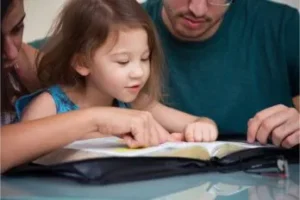
How Overwhelmed Parents Make Time For God’s Word
With so many distractions, staying focused on God’s Word requires intentional effort, but it doesn’t have to be hard.

Parents can teach toddlers about modesty, which builds an understanding and lays a foundation for future discussions.
When our now 11-year-old daughter was a toddler, we began to teach her about modesty. We did the same with her three younger sisters. We didn’t sit down and discuss skirt lengths or necklines over Cheerios and milk, though. Instead, our lessons were more basic and age-appropriate.
Young children don’t need to be schooled on certain clothing labels or the length of in-seams. In fact, best-selling author and speaker Dannah Gresh told me that, developmentally, toddlers may not yet be able to even process the concept of modesty.
“They still like very much to rip off their clothes and run naked as if they still live in Eden,” she explained. “I think that’s normal. But at about the age of 4 or 5, they should fully understand that boys and girls are different, and some things are meant to be private.”
Even if modesty isn’t a concept toddlers can fully grasp, parents can still use this age to lay a foundation for future discussions about modesty.
At this age, it’s natural for children to want to go without clothes. We explained to them that clothes were God’s idea. Adam and Eve didn’t go to the store and buy clothing. God designed, made and gave them clothes to wear (after they sinned).
With our girls, we told them that we keep our clothes on at other people’s houses and in public places. An easy way for them to remember this is: “We keep our clothes on when we’re not at home.” They were able to learn that fairly quickly. Then we taught them to shut the door when using the bathroom.
We read in Genesis 1:26-31 that after God created the first man and woman, the Bible declares them “very good.” We wanted our children to know that God made their bodies, and they are also “very good.” Their bodies are God’s masterpieces, and He wants to use them to do great things for Him.
To this end, we intentionally didn’t dress our 2-year-olds in clothes that we didn’t want them wearing at 15. This meant that at the pool and beach, we opted for more coverage, despite how cute their baby bellies were. Our purpose was to communicate our standards early when it came to clothes. We were concerned that if we waited until they were older to specify what styles were OK, then we’d be sending them mixed messages on whether or not there was something wrong with their bodies.
Gresh states that this can be an issue for parents. “If we wait until a child’s body is fully mature and then teach them modesty, the message gets confusing. Children may feel that their bodies are bad.” Kids need to understand that it’s certain clothing that may be the problem, Gresh explains, not their bodies. Teaching them modesty early — when their bodies are child bodies and not teen bodies — can help make this distinction clear.
Toddlers learn by imitating us — our words, behaviors and choices. As moms and dads, we can model modesty for our young sons or daughters through our actions and personal choices. Gresh advises, “Modeling what you teach is always vital. We cannot expect a child to live what we ourselves do not live.”
Being a role model gives you credibility to talk to them about their developing bodies when they are older. You can then build on the basic concepts you’ve instilled in them earlier.
Young children often learn best when you include a tactile experience. Here is an idea you can do to remind your young children that God made their bodies:
Print a free online paper doll that matches your child’s gender, or sketch your own. Make one for yourself, too. Spend time together coloring them and talking about how our bodies are God’s works of art.
Next, pull out fabric scraps that you’ve collected in advance. You can either cut up old clothes or buy a bundle of quilting squares at your local hobby store. Let your child feel the material and look at the different patterns. Choose one or two pieces and glue them on to your paper people. Reinforce that, while fashion may be humanity’s idea, clothes were God’s idea.
Cut out your people and talk about how we wear clothes when we go out. Take them with you on your next trip to the park, the store or a grandparent’s house. Your child will love showing off his or her masterpiece!